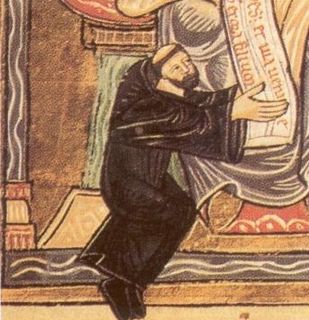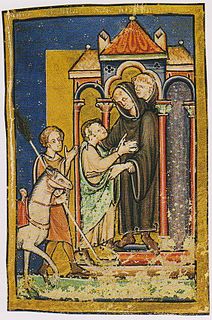
The Rule of Saint Benedict is a book of precepts written by Benedict of Nursia for monks living communally under the authority of an abbot.

Odo of Cluny was the second abbot of Cluny. He enacted various reforms in the Cluniac system of France and Italy. He is venerated as a saint by the Catholic and Eastern Orthodox Churches. His feast day is 18 November.
The County of Auxerre is a former state of current central France, with capital in Auxerre.

September 24 - Eastern Orthodox liturgical calendar - September 26

March 29 - Eastern Orthodox liturgical calendar - March 31

Fontenelle Abbey or the Abbey of St Wandrille is a Benedictine monastery in the commune of Saint-Wandrille-Rançon. It was founded in 649 near Caudebec-en-Caux in Seine-Maritime, Normandy, France.
Flavigny Abbey is a former Benedictine monastery, now occupied by the Dominicans, in Flavigny-sur-Ozerain, Côte-d'Or département, France. The monks at this abbey were the original makers of the well-known aniseed confectionery Anise de Flavigny.
Hugh the Abbot was a member of the Welf family, a son of Conrad I of Auxerre and Adelaide. After his father's death, his mother apparently married Robert the Strong, the margrave of Neustria. On Robert's death in 866, Hugh became the regent and guardian for Robert's sons, Odo and Robert.
Rodulfus Glaber (985–1047) was an 11th century French monk and chronicler.
Herbert of Selkirk was a 12th-century Tironensian monk, who rose to become 3rd Abbot of Selkirk-Kelso and bishop of Glasgow. While abbot of Selkirk, King David I of Scotland moved Selkirk Abbey to nearby Kelso. He was elected to the see of Glasgow soon after the death of his Bishop John, and consecrated by Pope Eugenius III at Auxerre on St Bartholomew's Day, 24 August 1147. He died in 1164.

The Abbey of St. Maurice, Agaunum is a Swiss monastery of canons regular in Saint-Maurice, Canton of Valais, which dates from the 6th century. It is situated against a cliff in a section of the road between Geneva and the Simplon Pass. The abbey itself is a territorial abbacy and not part of any diocese. It is best known for its connection to the story of the martyrdom of the Theban Legion, its original practice of perpetual psalmody, and a collection of art and antiquity.
Saint John of Gorze was a Lorraine-born monk, diplomat, administrator, and monastic reformer.

Saint Boisil was a monk of Melrose Abbey, an offshoot of Lindisfarne, then in the Anglo-Saxon Kingdom of Northumbria, but now in Scotland, where he must have been one of the first generation of monks. He probably moved to the new foundation of Melrose when it was started, probably some time in the late 640s.
Abbo of Auxerre was a Benedictine abbot and bishop of Auxerre.

Saint Anselm Abbey, located in Goffstown, New Hampshire, United States, is a Benedictine abbey composed of men living under the Rule of Saint Benedict within the Catholic Church. The abbey was founded in 1889 under the patronage of Saint Anselm of Canterbury, a Benedictine monk of Bec and former archbishop of Canterbury in England. The monks are involved in the operation of Saint Anselm College. The abbey is a member of the American-Cassinese Congregation of the Benedictine Confederation.

Redon Abbey, or Abbey of Saint-Sauveur, Redon, in Redon in the present Ille-et-Vilaine, Brittany, France, is a former Benedictine abbey founded in 832 by Saint Conwoïon, at the point where the Oust flows into the Vilaine, on the border between Neustria and Brittany.
In ancient Rome, Mamertinus was a cognomen. Notable men named Mamertinus include:
Lothair the Lame was a younger son of Charles the Bald and Ermentrude of Orleans. As he was born crippled, his parents sent him away to a monastery early in life. In 861, he became a monk. In his last years he was abbot of Montier-en-Der and Saint-Germain of Auxerre.

The Abbey of St. Marianus was a Benedictine, later Premonstratensian, monastery in Auxerre in the French department of Yonne in Burgundy. Established in the fifth century, it was the first monastery established in the diocese.
Saint Marianus of Auxerre was a monk of Auxerre in Yonne, France. He was considered a saint because of the sanctity of his life and is invoked as a protector of animals. His feast day is 20 April.












